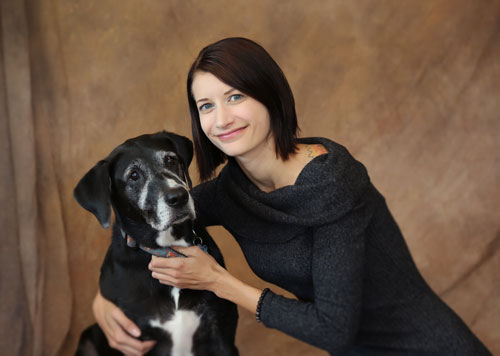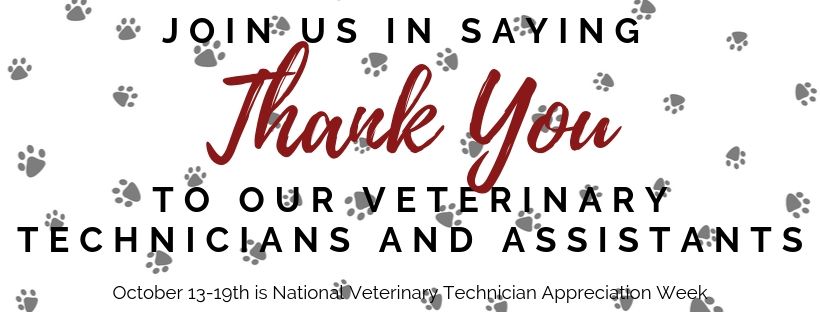Happy National Veterinary Technician Week
We are excited to celebrate National Veterinary Technician Week October 13th-19th, 2019!
What Is A Veterinary Technician or a Veterinary Assistant?
A veterinary technician is comparable to a nurse in the human medical field. Veterinary technicians have been educated in the care and handling of animals, the basic principles of normal and abnormal life processes, and in many laboratory and clinical procedures. In general, veterinary technicians obtain 2-4 years of post-high school education and have an Associate’s or Bachelor’s degree in Veterinary Technology. In addition, they must pass a credentialing examination and keep up-to-date with continuing education to be considered certified in Minnesota.
Veterinary technicians handle many of the same responsibilities that nurses, phlebotomists, radiology technicians, and nursing assistants perform for physicians – and they perform these skills not just on one species but on a variety of species including dogs, cats, rabbits, rodents, ferrets, and birds. At St Francis, our veterinary technicians obtain and record patient histories; triage phone calls; collect specimens and perform laboratory procedures; provide specialized nursing care; prepare animals, instruments, and equipment for surgery; monitor anesthesia; assist in diagnostic, medical, and surgical procedures; perform dental cleaning and charting procedures; expose and develop radiographs; advise and educate animal owners; perform laser therapy; assist with ultrasonography; perform avian grooming; and assist with hospice/palliative care and end-of-life care.
Veterinary assistants support the veterinarians and veterinary technicians in their daily tasks. Our veterinary assistants feed and exercise the hospitalized patients; assist in the handling of animals during appointments or while in the hospital; obtain medical histories during appointments; collect basic laboratory samples; assist with treatments including acupuncture; assist the pharmacy technician with prescriptions; educate animal owners; and maintain hospital cleanliness. Many of our veterinary assistants are students working towards their Certified Veterinary Technician (CVT) or Doctor of Veterinary Medicine (DVM) degrees.
What Makes Our Veterinary Technicians and Veterinary Assistants Extraordinary?
Many of the technicians and assistants at St Francis have taken on additional leadership roles within the practice including practice management, inventory management, radiation safety, hazardous waste, DEA, and employee management (Assistant Practice Manager, Veterinary Technician Supervisor, Veterinary Assistant Supervisor, Kennel Assistant Supervisor). Unique to St Francis, we also offer specialty positions called directorships for our more experienced technicians. We currently have a Director of Integrative Services, Director of Hospice & Palliative Care Services, Director of Laboratory Services, Director of Nutritional Services, Director of Behavioral Services, Director of Dermatology Services, and Director of Client Services. Many of our technicians and assistants have continued their education to achieve additional certifications in massage therapy, Fear-Free, Hospice & Palliative Care, and pet loss grief counseling.
Outside of work, you may find these individuals volunteering at the local bird rescue, managing their own pet-sitting businesses, volunteering at the Wildlife Rehabilitation Center, studying for upper level degrees, teaching, or volunteering at fundraisers to support animal health and well-being. Caring for animals is not just a job — it is a passion that spills into all aspects of their lives.
Take A Moment To Say Thank You!
We are so grateful for every one of our veterinary technicians and veterinary assistants. We are incredibly fortunate to have a team of the most talented, hard working, dedicated, compassionate, knowledgeable, and caring technicians and assistants in the Twin Cities. We couldn’t provide you and your loved ones with the exceptional care that we do without all of these individuals doing what they do best.
During this week, we ask you to take a moment to write a thank you or a special note to a veterinary technician or a veterinary assistant at St Francis who may have made a difference to you or to your pet. You may leave your message in the box on the front counter or send it via email to group@stfrancisabh.com. Next weekend, we’ll compile all of the notes and share them with our entire team. It will mean the world to them to know how much they are appreciated!
Help us to celebrate National Veterinary Technician Week at St. Francis Animal Hospital!
Employee Spotlight: Christine Capistrant, CVT, CMT, Director of Integrative Services
Each month, we will spotlight one of our team members in order of years of service at St. Francis Animal Hospital.
Chris joined St. Francis Animal Hospital in April 2014 after graduating from Globe University in March 2014 with her Associate of Applied Science (AAS) degree in Veterinary Technology. She is a Certified Veterinary Technician (CVT).
Chris continued her education to earn her Certification in Canine Massage Therapy (CMT) at Brandenburg Massage Therapy in Ohio in 2015. She currently serves as the Director of Integrative Services and performs massage therapy and laser therapy at St Francis Integrative Services.

She has a passion for animal rehabilitation and maintaining a pet’s quality of life as he or she ages. In addition to her roles as veterinary technician and Director of Integrative Services, she has been involved with the development of the hospice/palliative care and at-home euthanasia services. She is certified as a Pet Loss Counselor through the Association for Pet Loss and Bereavement (APLB).
She shares her home with her black lab mix, Shadow. In her free time, she loves kayaking, wildlife photography, and watching a good movie.
Why do you love being a veterinary technician?
I love seeing the human animal bond. I have always loved animals and being able to help these special family members.
Why do you love working at St. Francis Animal Hospital?
I love working at St. Francis because the team is great and the focus is always on the pet’s care and well-being. I love working at St Francis because the standards and ethics are high and everyone has a passion for what they do.
Happy Halloween: Beware of Chocolate Toxicity
Most people enjoy chocolate, and not surprisingly, most pets do too! Unfortunately, chocolate can be toxic to pets and can lead to severe clinical signs including vomiting, diarrhea, restlessness, hyperactivity, tremors, seizures, ataxia (‘drunkenness’), increased heart rate, heart arrhythmias, increased blood pressure, increased body temperature, difficulty breathing, and even death.
The toxic compounds in chocolate are methylxanthines – this includes both theobromine and caffeine. These compounds inhibit cellular receptors, stimulate the central nervous system, and enhance cardiac and skeletal muscle contractility. In addition, the high fat content in chocolate leads to local gastrointestinal irritation (vomiting and diarrhea), and in severe cases, a serious disease called pancreatitis. Clinical signs occur within 12 hours, but most pets will begin exhibiting signs within 1-4 hours of ingestion.
Different types of chocolate have different amounts of theobromine and caffeine. White chocolate has the least amounts while baker’s unsweetened chocolate and dry cocoa powder contain the highest concentrations. Although we generally consider 100 mg/kg to be a toxic dose, some patients will exhibit clinical signs at a dose as low as 20 mg/kg. Often we don’t know the type or amount of chocolate that was ingested, so it is best to proceed as if the ingestion was the worst-case scenario.
Treatment depends on the amount of methylxanthines ingested, the time of ingestion, and the patient’s clinical signs. If recent ingestion occurred, vomiting is induced to evacuate the stomach. In severe cases, sedation and gastric lavage with a stomach tube may be performed to evacuate the stomach contents. Activated charcoal is administered to bind the toxins in the gastrointestinal tract.
Fluid therapy, anti-vomiting medications, gastrointestinal protectants, and a bland diet may be prescribed. In severe cases, patients require intensive care including intravenous fluid therapy, continuous EKG monitoring, oxygen support, urinary catheterization, and intravenous medications to manage seizures, cardiac arrhythmias, and abnormal respirations.
If treated promptly, most patients with chocolate toxicity recover, but it is important to understand that chocolate ingestion can lead to severe complications and even death. It is best to avoid chocolate ingestion in your pet. During the holidays (Halloween, Valentine’s Day, and Easter) when chocolate is abundant, make sure it is kept out of reach of your pet.
If you suspect that your pet has ingested chocolate, contact us at (651) 645-2808.
News Briefs
Congratulations: Nutramax LiT Cooler Winner
Congratulations to Beardsley’s family for winning the LiT Cooler courtesy of Nutramax. Dr. Lewis started Beardsley on both Dasuquin and Welactin this month to help support his joints – and it paid off for everyone! Thank you to Nutramax!
Happy Anniversary!
We’d like to wish a Happy Anniversary to Dr. Patricia Novak (10 years), Madison Baumgartner (1 year) and Debranique Pitter (1 year). Thank you all for the wonderful work that you do at St Francis! We love having you on the team!
Welcome Back, Sarah Welch, CVT!
Welcome back, Sarah Welch, CVT! After spending time in a rural veterinary practice and a specialty ophthalmology practice, Sarah has returned to St Francis as our Director of Client Services. Please give her a warm welcome!

